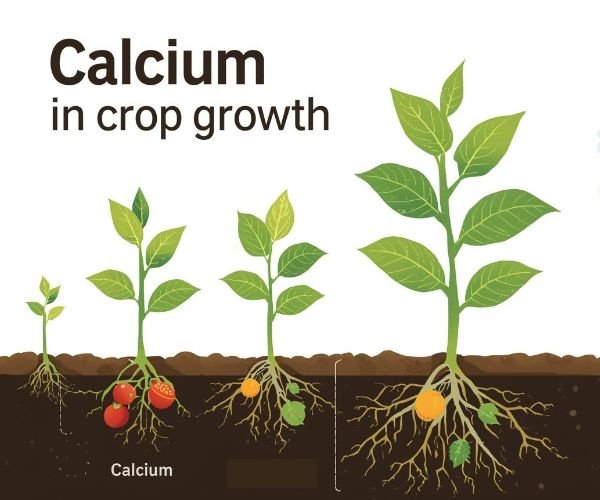Calcium (Ca) is the “rebar” of cell walls and fruit skins, but it cannot be redistributed through the phloem. It mainly moves with the transpiration stream to young shoots and fruits. This means that water and environmental conditions decide whether calcium reaches its target—choosing the right calcium source is only the second step.
1. What Does Calcium Actually Do in Crops?
- Structural reinforcement: Cross-links with pectins (Ca-pectate) in the cell wall, determining fruit firmness, toughness, and storability.
- Membrane stability: Stabilizes membranes, reduces leakage, and prevents physiological spots.
- Signal regulation: Acts as a second messenger in stress responses (heat, salinity, pathogens).
- Growth point essential: Root tips, shoot tips, young leaves, and young fruits are extremely sensitive to Ca—deficiency quickly causes rot, necrosis, or deformation.
📌 Key property: Calcium does not move via phloem redistribution (unlike N or K). It travels only with xylem transpiration flow—so tissues with stronger transpiration win first access.
2. Why Is Calcium Deficient Even When Soils Contain Plenty?
- Transport barriers
- High humidity / low airflow / warm nights → weak transpiration → Ca fails to reach young fruits.
- Irregular irrigation → fluctuating osmotic pressure → disrupted Ca flow.
- Root hypoxia / salinity stress → restricted Ca uptake.
- Competition at uptake sites
- Excess K, Mg, or NH₄⁺ competes with Ca²⁺, leading to apparent Ca deficiency.
- Poor positioning
- Calcium is immobile in soil: “where it’s placed is where it stays.” If far from roots, it’s unavailable.
- Foliar calcium mainly improves the sprayed tissues (leaf/fruit skin) but penetrates fruit flesh poorly.
👉 Logic first: manage environment and water → then consider calcium source and formula.
3. Typical Calcium Deficiency Symptoms
| Crop | Tissue/Stage | Symptoms | Notes |
|---|---|---|---|
| Tomato | Young fruit | Blossom-end rot (dark, sunken scar) | Often linked to water fluctuation and excess NH₄⁺/K |
| Pepper | Young fruit | Tip burn (shoulder/top rot) | Common under heat waves |
| Leafy veg / cabbage | Heart leaves | Tip burn, necrosis | Poor airflow + excess fast N |
| Strawberry | Flowers/young fruit | Misshapen fruit, cracking | Stable water + Ca supply at flowering/fruit set is key |
| Apple | Fruit | Bitter pit (brown spots, spongy tissue) | Pre-harvest Ca sprays help |
| Grape | Berries | Thin skin, cracking | Requires balance of Ca/K/Mg and stable transpiration |
4. Soil vs. Foliar Calcium: What Each Can Do?
Soil/Drip Application
- Role: Provides systemic Ca via transpiration flow to meristems and young fruits.
- Best use: All season; especially after fruit set during rapid cell expansion.
- Key conditions: Stable moisture, oxygenated roots, avoid high EC.
Foliar Application
- Role: Boosts Ca in sprayed tissues (leaf/fruit skin), enhancing firmness and storability.
- Limitations: Ca hardly enters fruit flesh—on tomato/pepper disorders, water balance matters more than foliar Ca alone.
- Best practice: Low-salt solution, multiple small sprays, avoid hot hours, fine mist without large droplets.
5. Common Calcium Sources & Usage
| Source | Soil/Drip | Foliar | Features & Notes |
|---|---|---|---|
| Calcium nitrate (Ca(NO₃)₂) | Frequent small doses; separate from phosphate/sulfate (A/B tank) | 0.3–0.5% | Supplies both Ca and nitrate-N; limit under high N demand or ripening |
| Calcium chloride (CaCl₂) | Use cautiously; sensitive crops may suffer | 0.2–0.5% | High scorch risk, avoid heat and young tissues; always pre-test |
| EDTA-Ca | Applicable via drip, stable | 800–1000× dilution | Better compatibility than free Ca; still test mixes |
| Amino acid / Glycine-Ca | Drip & foliar both possible | 800–1000× dilution | Fast leaf uptake; also supplies organic N |
| Gypsum (CaSO₄·2H₂O) | Soil amendment, slow-release | Not for foliar | Improves structure, long-term Ca pool |
| Lime/Dolomite | Base application, pH correction | Not for foliar | pH adjustment rather than fast Ca supply |
6. Mixing Compatibility “Red Lines”
- Must be separated:
- Free Ca (nitrate/chloride) × phosphates/sulfates → precipitation.
- Strong alkaline copper/sulfur products × chelated/organic Ca → chelate breakdown, higher phytotoxicity risk.
- Safer combinations:
Chelated Ca (EDTA, glycine, amino acid types) have better compatibility at proper pH and low concentrations—but always jar test first. - Fertilizer mixing order:
Water → pH adjust → main NPK → chelates (Ca/Mg/micronutrients) → suspension products → oils/adjuvants last. - A/B tank strategy: Keep Ca fertilizers separate from phosphates/sulfates until final mixing point.
7. Crop-Specific Guidelines
- Tomato/Pepper (protected cultivation)
- Root: Calcium nitrate frequent small doses, stable irrigation.
- Foliar: Chelated Ca 800–1000× at cool hours; focus more on water stability than foliar alone.
- Cucumber
- Root: Calcium nitrate under low-salt conditions, EC 1.5–2.2 (1:5 extract).
- Foliar: Chelated Ca, always jar test before mixing with high-P formulas.
- Strawberry
- Root: Ensure Ca availability from pre-bloom through fruit set.
- Foliar: Chelated Ca fine mist after flowering, avoid droplets hanging.
- Grapes
- Root: Stable Ca supply during berry growth, balanced with K and Mg.
- Foliar: Multiple sprays with chelated Ca before and around veraison, avoid heat stress.
- Apple
- Root: Continuous Ca supply, control N and water fluctuations.
- Foliar: CaCl₂ (0.2–0.5%) or chelated Ca (800–1000×), multiple pre-harvest sprays. Strictly avoid hot conditions and young leaves.
8. Key Takeaways
- Nature of Ca: immobile in phloem, delivered only by transpiration flow.
- First priority: stable environment (night temp, humidity, irrigation).
- Soil strategy: frequent small Ca doses, avoid NH₄⁺ dominance and high salinity.
- Foliar strategy: cool hours, fine mist, repeated sprays with chelated Ca or CaCl₂.
- Mixing safety: keep Ca separate from phosphates/sulfates; jar test first.
👉 Golden rule: Make calcium “move effectively” before trying to “apply more.”
At Wellyou Tech, we provide reliable calcium fertilizers and integrated crop nutrition solutions to help growers strengthen fruit quality, storability, and market value. Contact us to design the right Ca program for your crops.


